|
|
|
Sort Order |
|
|
|
Items / Page
|
|
|
|
|
|
|
| Srl | Item |
| 1 |
ID:
126774
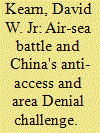

|
|
|
|
|
| Publication |
2013.
|
| Summary/Abstract |
The challenge presented by china's military modernization has seemingly altered the conventional balance in the western pacific, with significant implications for U.S. national security policy, and, thus, deserves the focus of planners and decision-makers.
|
|
|
|
|
|
|
|
|
|
|
|
|
|
|
|
| 2 |
ID:
130440
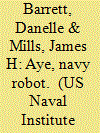

|
|
|
| 3 |
ID:
156937
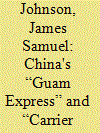

|
|
|
|
|
| Summary/Abstract |
A new generation of stealthier, supersonic, autonomous, and increasingly survivable Chinese anti-ship missiles (ASMs) with extended ranges, payloads, and accuracy are increasingly adept at evading U.S. defenses, and undermine the effectiveness of its surface fleets and carrier strike groups in the West Pacific. This article conceptualizes the evolution of Chinese ASMs through a structural-realist theoretical lens. It argues that the development and diffusion of these asymmetric precision-strike weapons have in important ways intensified U.S.-China security-dilemma dynamics, which could portend a paradigm shift (or at least the perception of one) in the future military balance of power in Asia.
|
|
|
|
|
|
|
|
|
|
|
|
|
|
|
|
| 4 |
ID:
158620
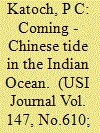

|
|
|
| 5 |
ID:
131114
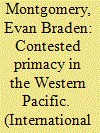

|
|
|
|
|
| Publication |
2014.
|
| Summary/Abstract |
Despite their disagreements, proponents of deep engagement and offshore balancing share an optimistic but unrealistic assessment of U.S. military power. In particular, both sides in the debate over U.S. grand strategy underestimate the potential consequences of China's military modernization. China's antiaccess/area denial strategy and conventional precision-strike capabilities are already undermining the United States' ability to prevent local conflicts, protect longtime allies, and preserve freedom of the commons in East Asia. Whether the United States intends to uphold the status quo when threats emerge or adopt a wait-and-see approach to regional conflicts, it will need to adapt its military for power projection operations in much less permissive environments than it has become accustomed to during the unipolar era. These adaptations include developing air and undersea platforms that can survive inside denial zones, forward bases that are better able to withstand attacks, and satellite and cyberspace networks that are less vulnerable to disruption.
|
|
|
|
|
|
|
|
|
|
|
|
|
|
|
|
| 6 |
ID:
156377
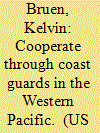

|
|
|
| 7 |
ID:
130061
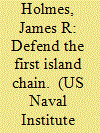

|
|
|
|
|
| Publication |
2014.
|
| Summary/Abstract |
A strategic solution to the troubled waters of the Western Pacific is perimeter defense-but what kind? History offers options.
Want to give China an ulcer, a nagging sore that compels Beijing to think twice about aggression? Then look at the map. Geography affords the U.S.-Japan alliance abundant opportunities to make trouble for the People's Liberation Army (PLA), denying China's military access to the vast maneuver space of the Western Pacific while hampering its movements up and down the Asian seaboard. Fortifying the offshore island chain while deploying naval assets in adjoining waters could yield major strategic gains on the cheap. Doing so is common sense. The only question is how.
|
|
|
|
|
|
|
|
|
|
|
|
|
|
|
|
| 8 |
ID:
133778
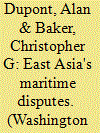

|
|
|
|
|
| Publication |
2014.
|
| Summary/Abstract |
Few doubt that China's rise is this era's principal driver of strategic change, just as the United States' equally influential ascendancy shaped the last. But earlier optimism that the Middle Kingdom's re-emergence as a major power would be largely benign is fading as evidence mounts that Beijing is determined to press its territorial and resource claims in the vitally important seas of the Western Pacific. In barely the blink of a geopolitical eye, China's once lauded charm offensive has given way to exactly the kind of coercive behavior its critics have long predicted.1 In a 3,000-mile maritime arc running from the East China Sea to the southern reaches of the South China Sea, Beijing is at loggerheads with many of its neighbors, including erstwhile friends, over several linked territorial and resource disputes. If not wisely managed, these disputes could bring East Asia's long peace to a premature and bloody end.
|
|
|
|
|
|
|
|
|
|
|
|
|
|
|
|
| 9 |
ID:
147045
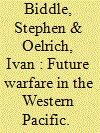

|
|
|
|
|
| Summary/Abstract |
Many analysts worry that improvements in Chinese missile, sensor, guidance, and other technologies will enable China to deny the U.S. military access to parts of the Western Pacific that the United States has long controlled. Although these “antiaccess, area denial” (A2/AD) capabilities are real, they are a geographically limited long-term threat. As both the United States and China deploy A2/AD capabilities, a new era will emerge in which the U.S. military no longer enjoys today's command of the global commons, but is still able to deny China military hegemony in the Western Pacific. In this new era, the United States will possess a sphere of influence around allied landmasses; China will maintain a sphere of influence over its own mainland; and a contested battlespace will cover much of the South and East China Seas wherein neither power enjoys wartime freedom of surface or air movement. This in turn suggests that the Chinese A2/AD threat to U.S. allies is real but more limited than often supposed. With astute U.S. choices, most U.S. allies in this new system will be imperfectly, but substantially, secure.
|
|
|
|
|
|
|
|
|
|
|
|
|
|
|
|
| 10 |
ID:
131725
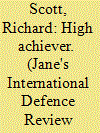

|
|
|
|
|
| Publication |
2014.
|
| Summary/Abstract |
The United Kingdom is funding further work to explore the potential of the Sampson multifunctional radar (MFR) to detect and track ballistic missile following the success of a live tracking experiment in the western pacific in September 2013.
|
|
|
|
|
|
|
|
|
|
|
|
|
|
|
|
| 11 |
ID:
143998
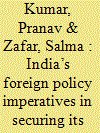

|
|
|
|
|
| Summary/Abstract |
Seas and Oceans have always played an important role in human development and continue to do so in number of ways, be it as a source of resource or as a means of transportation or information exchange. In the twenty-first century with the emergence of current globalised world trade system, its strategic importance has increased many folds.
|
|
|
|
|
|
|
|
|
|
|
|
|
|
|
|
| 12 |
ID:
133693
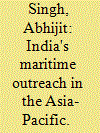

|
|
|
|
|
| Publication |
2014.
|
| Summary/Abstract |
In the past few years, New Delhi's drive to improve maritime relations with East and South East Asia has acquired a frisson of urgency. India's "Look-East" Policy, a largely trade and commerce oriented framework guiding interactions with nations to lndia's East, has now acquired a prominent nautical edge. With increased maritime forays and a clear articulation by the political leadership, ofthe principle of "freedom of navigation" and an "open and inclusive" architecture of global maritime security, New Delhi has shown it is inclined to treat the Western Pacific as a theatre of commercial and maritime security interests.
|
|
|
|
|
|
|
|
|
|
|
|
|
|
|
|
| 13 |
ID:
142811
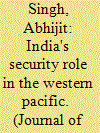

|
|
|
| 14 |
ID:
153186
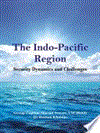

|
|
|
|
|
| Publication |
New Delhi, Vij Books India Pvt Ltd, 2016.
|
| Description |
xxiii, 172p.hbk
|
| Standard Number |
9789385563706
|
|
|
|
|
|
|
|
|
|
|
|
Copies: C:1/I:0,R:0,Q:0
Circulation
| Accession# | Call# | Current Location | Status | Policy | Location |
| 059084 | 355.033091824/TEW 059084 | Main | On Shelf | General | |
|
|
|
|
| 15 |
ID:
130757
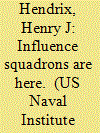

|
|
|
|
|
| Publication |
2014.
|
| Summary/Abstract |
All the components seem to be in place to make 'payloads over platforms' a reality for the Navy.
Funny thing about the future: It's dreamed about, planned for, anticipated, and then, suddenly it just shows up. Most of the time it does not occur the way it was imagined. So many factors are involved in day-to-day life for events to unfold as expected, but sometimes, perhaps with sufficient attention to the past to get a good sense of strong currents in the river of time, reasonable forecasts of near-term events can be made. Such is the case, at least partially, with the development of the Navy's shipbuilding plan and the evolution of its force structure. Whether called by name or not, influence squadrons have all but arrived.
|
|
|
|
|
|
|
|
|
|
|
|
|
|
|
|
| 16 |
ID:
188453
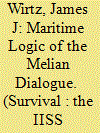

|
|
|
|
|
| Summary/Abstract |
There is a maritime logic embedded in Thucydides’ ‘Melian Dialogue’ that until now has attracted little notice; observers have instead concentrated on the deeper philosophical and moral issues highlighted by Thucydides in his tale drawn from the Peloponnesian War. Nevertheless, the maritime logic that propelled a confrontation on the island nation of Melos nearly 2,500 years ago could re-emerge in the run-up to a conflict in the Western Pacific. Allies are the strategic enabler of the US naval presence in the region, and US forces are taking steps to develop concepts and doctrine to enable operations in and along the First Island Chain. Denying access to these logistical facilities might be a political priority for China in the run-up to potential military action, and it would not be surprising if Beijing delivered a simple message to the inhabitants of the First Island Chain: stay out of it, and we will leave you out of it. All of this suggests that the idea of ‘neutrality’, as encountered in the Melian Dialogue, might again emerge during a crisis. Because the incentives to restrict US access to forward-operating bases are so clear-cut, strategists need to anticipate the emergence of ideas related to limiting the ability of US naval units to use port and air facilities in the Western Pacific.
|
|
|
|
|
|
|
|
|
|
|
|
|
|
|
|
| 17 |
ID:
102664


|
|
|
|
|
| Publication |
New York, DoubleDay, 2011.
|
| Description |
xvii, 243p.:illHbk
|
| Standard Number |
9780385532945
|
|
|
|
|
|
|
|
|
|
|
|
Copies: C:1/I:0,R:0,Q:0
Circulation
| Accession# | Call# | Current Location | Status | Policy | Location |
| 055834 | 909.831/FRI 055834 | Main | On Shelf | General | |
|
|
|
|
| 18 |
ID:
132955
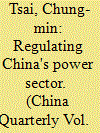

|
|
|
|
|
| Publication |
2014.
|
| Summary/Abstract |
Throughout its period of economic transition, the Chinese state has readjusted its relationship with industry and developed new regulatory schemes. China's first industry-specific independent regulatory agency, the State Electricity Regulatory Commission (SERC), was created in 2003. Its operation does not follow Western practice which adopts the best institutional arrangement for autonomous regulators. This article will examine the failings and regulatory capture of SERC. I argue that because the process of creating a new regulator involves resource reallocation and power redistribution, SERC has suffered both endogenous and exogenous disadvantages since its inception. The compromised institutional design, along with insufficient resources and fragmented authority, has considerably weakened SERC's regulatory capacity. Moreover, SERC was not designed as part of the reform schedule, but rather emerged later as a response to institutional necessities, which also contributes to its vulnerability. As a result, the state has exposed SERC to potential capture by both government entities and regulated enterprises.
|
|
|
|
|
|
|
|
|
|
|
|
|
|
|
|
| 19 |
ID:
141604
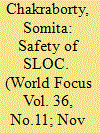

|
|
|
|
|
| Summary/Abstract |
In the post Cold War era, India’s growing diplomatic initiative and naval presence in different ports of Indian Ocean and western Pacific for the protection of its vital sea lanes received tremendous international attention. Much of the existing literature regards this as an exercise of power projection, ignoring the economic dimension as well as diplomatic initiatives taken by India for the safety of its vital sea lanes.
|
|
|
|
|
|
|
|
|
|
|
|
|
|
|
|
| 20 |
ID:
171608
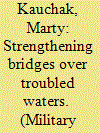

|
|
|
|
|
|
|
|